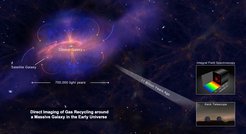Direct Imaging of Gas Recycling around a Massive Galaxy in the Early Universe
Galaxies are the birthplace of most stars and black holes. However, scientists are still debating, how galaxies accrete the fuel to sustain their growth, and how they in turn pollute their environment with elements heavier than helium. An international team of astrophysicists has now directly observed the neighborhood of a massive galaxy in the early universe. They find that the gas all around the galaxy is enriched with heavy elements, which means it has been polluted by the galaxy itself and by embedded satellite galaxies. Furthermore, this gas is spiraling onto the massive galaxy, fueling further star formation.
According to the first models of galaxy formation, gas fell isotropically onto dark matter halos, was shock-heated to very high temperatures (millions of degrees), and subsequently cooled to form stars in the growing central galaxy. However, it is now clear that this so-called ‘hot-mode’ accretion accounts for only a small fraction of the fuel powering the violent star formation in massive galaxies in the early universe. Instead, cosmological hydrodynamical simulations indicate that a ‘cold-mode’ accretion (thousands of degrees) onto galaxies occurs along filaments. This accretion process is more efficient in transporting gas down to the galaxy, providing a natural mechanism to sustain the observed large star-formation rates.
In turn, stars pollute their surrounding environment with elements heavier than helium, globally referred to as “metals”. The most energetic phenomena (supernova explosions) are even able to generate galactic outflows, enriching the circumgalactic gas. Recent cosmological simulations indicate that this metal-enriched gas ejected by the galaxy could fall back, resulting in a further supply mechanism to sustain intense star-forming activity. Therefore, a massive galaxy will both recycle its metal-polluted gas and use pristine, inflowing gas. However, direct observational evidence for the presence of such recycled inflows had not been obtained so far.

An international team of astronomers has therefore targeted a massive system in the early universe, to get a first glimpse on how such galaxies accrete their gas. The chosen system, MAMMOTH-1, can be observed at an epoch corresponding to 11 billion years ago. It is a galaxy group embedded in large-scale cold circumgalactic gas, which shines bright in Lyman-alpha emission from hydrogen.
With data from the Keck Cosmic Web Imager (KCWI, Keck II telescope) and narrowband imaging from the Subaru telescope, the team detected circumgalactic line emission in hydrogen, helium, and carbon extending for 300 000 light years. An analysis of the line ratios allowed the team to obtain the gas properties throughout the halo. The results show that the circumgalactic gas has already been enriched to about solar metallicity, which is quite surprising at this early cosmic epoch.
Further, the KCWI data allowed the team to analyse the kinematics of the emitting gas in the observed region. A detailed comparison of the data with cosmological simulations developed at the Max Planck Institute for Astrophysics and with an analytical model can explain the observed velocity patterns, which are most likely due to recycled inflow gas. The kinematic model indicates that the gas accretion is occurring at a rate of about 700 solar masses per year, much more than the measured star-formation rate of the central galaxy (81 solar masses per year). The metal-enriched inflow could thus fully sustain the intense star formation in the massive galaxy. “Our observations give a first hint that recycled inflows might be an ubiquitous supply mechanism for massive star-forming galaxies in the early universe”, remarks Shiwu Zhang of Tsinghua University and first-author of the study.
MAMMOTH-1 with circumgalactic gas and satellite galaxies
In addition, the team also found that satellite galaxies in this galaxy group have the same motion as the circumgalactic gas, indicating that they are embedded in the inspiraling streams. Therefore, these satellite galaxies could interact with and pollute the circumgalactic gas. “This makes the galaxy-gas ecosystem even more complex, but also it makes more plausible that gas recycling is an important ingredient,” adds Zheng Cai of Tsinghua University and second-author of the study.
“We need a lot more sensitive observations of circumgalactic emission to give us more insights on the intricate ecosystem of galaxies”, points out Fabrizio Arrigoni Battaia, co-author and scientist at the Max Planck Institute for Astrophysics. “Our approach together with the upcoming exquisite datasets, such as from the MUSE/VLT, KCWI instruments, and JWST, allows us to directly study the circumgalactic gas in detail and thus better understand the physical processes governing the gas cycle around galaxies.”












